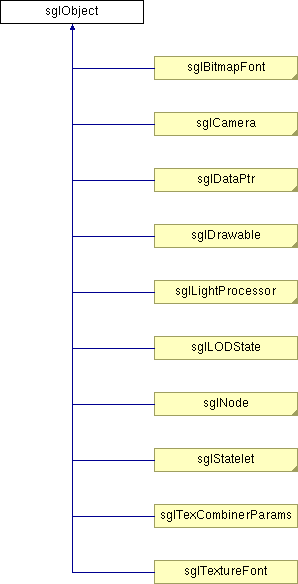
#include <sglObject.hpp>
Inheritance diagram for sglObject::

Public Types | |
| enum | CloneModeEnum { eCLONE_ONE_NODE = 0, eCLONE_NODES_RECURSIVE = 0x01, eCLONE_USER_DATA = 0x02 } |
Public Methods | |
| sglObject () | |
| virtual | ~sglObject ()=0 |
| void | ref () |
| void | deref () |
| unsigned int | getRefCount () const |
| void | setName (const string &name) |
| const string& | getName () const |
| void | setUserData (sglUserData *data) |
| sglUserData* | getUserData () const |
| virtual void | printInfo (ostream &ostrm, const char *indent_string) const |
Protected Methods | |
| void | copyTo (sglObject *dst, unsigned int mode) const |
Protected Attributes | |
| unsigned int | m_ref_count |
| sglUserData* | m_user_data |
| string | m_name |
Reference Counting
All objects in the scene graph are (or should be) reference counted. Whenever a node is added as a child to another (see sglGroup), the node's reference count is incremented. Likewise, the reference count is decremented when the node is removed as a child to another node. If the reference count goes to zero it is safe to destruct the object as it is no longer referenced by anything in the scene graph. The scene graph does not automatically destruct a node when its reference count goes to zero (particularly when calling sglGroup::removeChild() or sglGeode::removeGeometry()). The exception to this rule is the destruction of statelets if their reference count goes to zero during a call to sglDrawable::removeState().
Another circumstance in which SGL will automatically destruct an sglObject is when an sglObject references other sglObjects (as in the cases of child sglNodes of an sglGroup, child sglDrawable's of an sglGeode, or sglStatelets of an sglDrawable) and is destructed, the reference counts of those objects it references is decremented. If at anytime those reference counts goes to zero, then those objects are destructed as well. The process continues recursively to all objects in the scene graph below the object destructed by the user.
The user may also explicitly increment and decrement the reference count with ref() and deref() member functions. For example, the ref() function can be called when the object is an integral part (member) of another class or even allocated off the stack to prevent improper destruction of the object. Caution: if deref() is attempted for an sglNode that has a reference count of zero, causes an assertion failure.
NOTE: not all data in the scene graph is currently reference counted and special care must be taken by the user to manage it. This is most important for the attribute data referenced by sglDrawable nodes (vertices, normals, color vertices, and index arrays and their states (texture coordinates).
Application-specific data
An application that uses SGL can associate application specific data with any of the classes derived from sglObject. The only caveat is that the application's user data must be encapsulated in a class derived from sglUserData.
The printInfo function
All subclasses of sglObject should also implement the printInfo function that first calls its base class' version of this function and then outputs an informational data about the node's current state. This function is used in a couple of sglu functions for outputting all or portions of a scene graph (good for debugging).
Example:
sglGroup *node = new sglGroup; // a subclass of sglObject (via sglNode)
node->setName("Foo"); // sets name
char *name = node->getName(); // returns pointer to name
node->printInfo(cout, " "); // output node info to cout w/ 2 space indent
node->ref(); // increment the reference count
unsigned int count = node->getRefCount(); // returns 1
node->deref(); // decrement the reference count
node->deref(); // ERROR: causes assertion failure
Proposal: subclass from an sglMemory class to manage/track memory allocation?
Definition at line 112 of file sglObject.hpp.
|
|
Mode bits for the clone traversal function in sub classes
Definition at line 117 of file sglObject.hpp. |
|
|
default constructor.
|
|
|
destructor: pure virtual to ensure abstractness.
|
|
|
Increment the reference count.
Definition at line 142 of file sglObject.hpp. Referenced by sglTexCoords::sglTexCoords(). |
|
|
Decrement the reference count. An assertion failure will occur if this count goes negative. Definition at line 147 of file sglObject.hpp. |
|
|
Get the current reference count.
Definition at line 152 of file sglObject.hpp. |
|
|
Set the name of this object (the string is copied into this object).
Definition at line 157 of file sglObject.hpp. |
|
|
Get the name of this object
Definition at line 162 of file sglObject.hpp. |
|
|
Set the user data. This data will NOT be destructed with this sglObject.
Definition at line 169 of file sglObject.hpp. |
|
|
Get the user data pointer
Definition at line 174 of file sglObject.hpp. |
|
 1.2.6 written by Dimitri van Heesch,
© 1997-2001
1.2.6 written by Dimitri van Heesch,
© 1997-2001